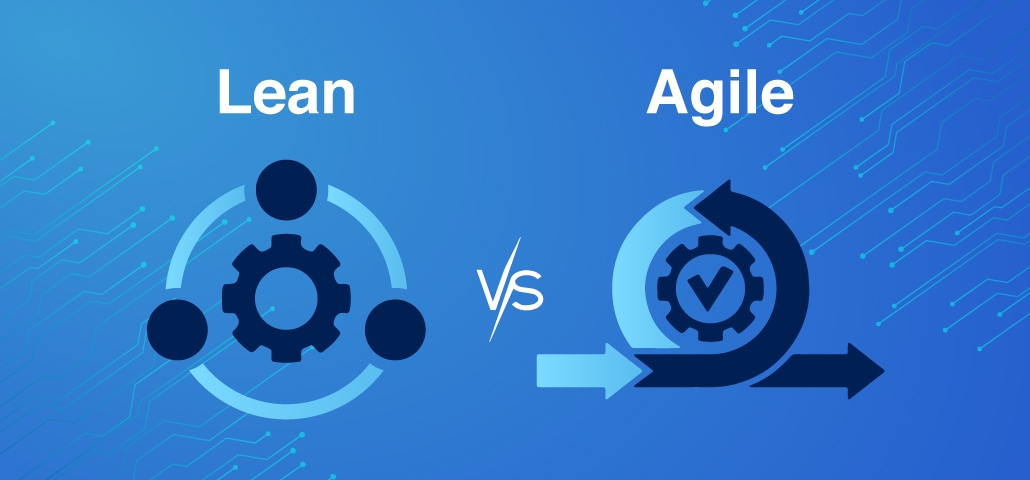
Table of Content
If you've ever done a little reading on modern software project management methodologies, you've likely come across terms like Lean and Agile. While the two approaches are similar, and a lot of software developers get confused even in the professional industry, understanding the differences between the two will help you decide how to structure the real processes that drive bespoke software development.
What is the difference between Lean and Agile, or how are they similar?
How do you know which one to use and when? We've got you covered!

Agile (1980s): Born out of frustration with sluggish software development (Waterfall method), Agile prioritizes speed and flexibility. The Agile Manifesto emphasizes continuous stakeholder involvement through short development cycles, allowing software to adapt to changing needs.
Lean (1970s): Inspired by minimizing waste in grocery store inventory, Taiichi Ohno's Toyota Production System (TPS) focused on efficiency. Lean principles were adopted for custom software development by Mary and Tom Poppendiek, focusing on eliminating waste throughout the software development process to deliver maximum value.
Agile is now generally recognized in the technology industry as a set of ideals and concepts that guide software development. "The Agile Manifesto" outlines four values and twelve principles.
Agile, at its foundation, is exactly what you'd expect. It's agile. The methodology emphasizes flexibility, communication, collaboration, and simplicity.
The term "lean" originated in lean manufacturing and is now used in operations. This is a collection of concepts designed to accomplish alignment, speed, and quality to consumer expectations.
To become lean, an organization seeks to eliminate components that do not provide value to the business. Such waste can be viewed in a variety of ways, ranging from mistakes in inventories and overproduction of products to lengthy approval processes and superfluous documentation.
The guiding principle behind lean operations is to focus solely on what adds value and eliminate superfluous items that waste time. With reduced waste, employees can operate at full efficiency.
Lean and Agile are two common approaches to software development, however they approach efficiency from distinct perspectives. Let's look at the important distinctions to assist you choose the best fit for your project.
Lean: Optimizes the development process by removing waste (unnecessary stages) and delivering maximum value to the client.
Agile: Emphasizes adaptability and flexibility, enabling the project to adjust to changing needs throughout the development cycle.
Lean: Ideal for projects with well-defined needs and an emphasis on efficient production and delivery.
Agile: It is ideal for projects with changing requirements or unclear characteristics. Agile thrives in circumstances where rapid flexibility and responsiveness are required.
Lean: Lean methodology focuses on minimizing time and resources spent on needless tasks. It delivers high-quality software that prioritizes client value and encourages ongoing improvement through process optimization.
Agile: Adapts to changing demands and priorities during the development process. It produces functioning software in short iterations, allowing for early feedback and course correction and also encourages strong collaboration among developers and stakeholders.
Lean: Lean requires a cultural shift toward waste elimination and continual improvement. It may not be suitable for projects with very unclear requirements.
Agile: Can be disruptive if not managed properly, perhaps leading to pandemonium. Customers and stakeholders must be involved at all stages of the project.
Lean: Use Kanban boards and value stream mapping to visualize workflows and detect bottlenecks. Uses procedures such as Just-in-Time (JIT) inventory management to reduce waste. Training in Lean principles and technologies is required for effective implementation.
Agile: Uses tools such as Agile boards and burn-down charts to monitor progress and remaining work. Follows a sprint (short development cycle) process, with daily standup meetings and regular retrospectives to analyze progress and change the plan. Agile training for roles (product owner, scrum master) and processes (sprints) is required.
When picking between Lean and Agile, consider the following factors:
Explore Further: Agile Vs Waterfall
While both Lean and Agile can lead to better productivity and customer satisfaction, the ideal method for your company depends on the specific project and general culture. Consider the project's requirements, your team's capabilities, and the project's timetable.
At Prioxis, we understand that having the perfect software development methodology is only half the battle; the right team is essential to success. If you’re looking to hire a skilled developer for your Agile or Lean projects, we’re here to help. Contact Prioxis today, and let us help you scale your team seamlessly.
Get in touch